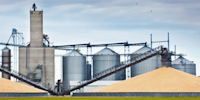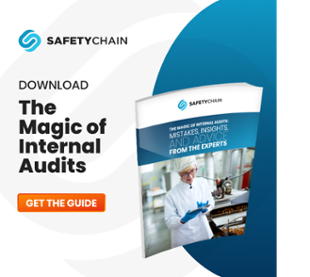What is a HARPC Plan & Does Your Company Need One?
Food & Beverage companies utilize several tactics to ensure the safe handling of food products. One important method for companies under the FDA’s Food Safety Modernization Act (FSMA) to follow is HARPC. If you want a guide to understanding FSMA Compliance, check out this blog post! Not to be confused with HACCP, HARPC is legally required for most food companies that fall under FSMA. If you are wondering what your facility needs to do to be HARPC compliant? Which Hazards Must Be Identified Under HARPC? And more, keep reading!
What Does HARPC Stand For?
HARPC stands for Hazard Analysis and Risk-Based Preventive Controls. The term originates from the Preventive Controls Rule of FSMA, which was enacted in 2011 to prevent food safety issues instead of after they occur proactively. Under the Rule, all food facilities must conduct HARPC and establish preventive control measures to minimize the risk of contamination in their food supplies.
HARPC Principles
The Preventive Controls Rule is a core component of FSMA, which aims to minimize risks through a strong, well-written food safety plan that is implemented effectively. The Rule’s HARPC principles require food manufacturers, processors, packers, and storage facilities to:
Identify known or reasonably foreseeable hazards to food safety associated with the facility’s processes, including chemical, physical, and biological hazards
Implement controls to mitigate the hazards (known as preventive controls)
Verify that the controls are working effectively
Create and implement corrective actions when deviations from controls occur
What is a HARPC Food Safety Plan?
Before FSMA, many companies had already identified risks using Hazard Analysis and Critical Control Points (HACCP) procedures. Under FSMA, however, Food Safety Magazine explains that HARPC “is a new process that requires identification and prevention of all reasonably foreseeable food safety hazards – whether naturally occurring or unintentionally introduced into the facility.” HARPC encompasses both the food safety plan and the tactics manufacturers or processors use to implement the plan.
Food companies must perform the following tactics to develop a FSMA-compliant HARPC plan:
Hazard Analysis
For this requirement, facilities must conduct a hazard analysis across processing, manufacturing, packing, and holding steps. HARPC food safety plans encompass a more comprehensive approach to hazard identification and analysis than HACCP. Beyond biological, chemical, and physical hazards, HARPC considers radiological hazards, which are not included in HACCP.
Additionally, HARPC requires the analysis of every known or reasonably foreseeable hazard, including those that occur naturally, unintentionally, or intentionally. For every hazard identified—not just critical hazards—preventive controls must be written and enforced.
Preventive Controls
This requirement calls for the development and implementation of risk-based preventive controls to minimize or prevent hazards identified in the previous step. Additional types of preventive controls covered by HARPC include process controls, sanitation controls, and food allergen controls.
Ongoing Monitoring of Preventive Controls
Facilities must also create a written plan to oversee and manage the controls of the identified hazards. Plans must encompass monitoring, corrective actions, verification activities, and verification of the ongoing scientific validity and relevance of preventive controls.
Corrective Actions
Corrective actions should be taken any time preventive controls are not properly implemented, there are any questions regarding a preventive control or the effectiveness of food safety plans, or there are missing details or discrepancies in the records or implementation of the food safety plan.
Corrective actions should encompass the following steps:
Identify weaknesses in the controls or controls that are entirely ineffective
Identify new hazards
Perform steps required to minimize the likelihood of recurrence
Evaluate the product for safety
Prevent adulterated food from entering commerce
Verification
HARPC requires food companies to use verification steps as a means of ensuring the plan’s effectiveness. Hazard identification and analysis, preventive controls, and monitoring must all be verified through steps that ensure the plan is preventing or minimizing hazards. Verification steps should aim to ensure:
The preventive controls are effective
Monitoring is happening as outlined by the plan
Corrective actions are being taken as needed
Hazards are being reduced
Periodic reviews are taking place to account for new risks
Risk-Based Supply Chain Program
Receiving facilities have flexibility over controlling raw materials under HARPC. When suppliers or third parties implement controls to mitigate hazards, the receiving facility can rely on those through a risk-based supply chain program and does not have to establish its own preventive controls.
Nonetheless, every receiving facility must set up a comprehensive supply chain program based on identified and likely risks to ensure any hazards are effectively controlled. Under this program, receiving facilities must approve suppliers through a comprehensive assessment of factors such as supplier performance and the nature of any hazards. Then, receiving facilities must identify verification activities to ensure that the supplier’s controls adequately reduce or prevent hazards. These activities could include audits and testing.
Recordkeeping & Documentation
Like other aspects of FSMA, all of the HARPC must be thoroughly documented, including the preventive controls. Prior to FSMA, the FDA could only require food companies to maintain records one step forward and one step back. Now, however, companies under HARPC must retain records and documents relating to food hazards and process control systems for at least two years if they relate to:
The monitoring of preventive controls
Corrective actions
Test results or other verification steps
The supply chain program
Training
Ultimately, the FDA requires records to be kept of the HARPC plan in its entirety, including the problem, process, and proof.
Requirement to Reanalyze
The HARPC plan must be reassessed periodically (every three years or upon a significant facility change).
Which Hazards Must Be Identified Under HARPC?
A comprehensive HARPC plan must identify all of the following known or foreseeable hazards that could affect a food facility:
Biological, physical, chemical, and radiological hazards
Allergens, drug residues, natural toxins, pesticides, and unapproved additives
Naturally occurring or unintentionally introduced hazards
Intentional hazards (such as acts of terrorism)
What Are Some Examples of Preventive Controls for HARPC?
Every facility will have its own unique preventive controls, as no two plants share the same exact risks. With that in mind, here are a few examples of preventive controls that could be implemented in a food processing facility:
Sanitation processes at any food surface contact points
Comprehensive hygiene training for all staff members
Environmental monitoring program
Food allergen controls
Supplier verification activities to assess and mitigate risks
Current good manufacturing practices (cGMPs)
Who Needs a HARPC Plan?
Virtually all food manufacturers, processors, packers, and storage facilities fall under this aspect of FSMA and must conform to FDA standards. With the exception of very small businesses, the majority of U.S. food will originate in or pass through facilities that fall under HARPC to some degree.
Nearly all facilities subjected to the FDA’s Bioterrorism Facility Establishment registration (in the U.S. and elsewhere) with foods being distributed in the U.S. must create and implement a HARPC plan. Facilities must also be prepared to provide a copy of their plan to the FDA after a written or oral request is made.
Who Is Exempt From HARPC?
While many Food & Beverage companies are subject to the Preventive Controls Rule of FSMA and must therefore comply with HARPC, there are some exceptions. Here are the categories of exemptions from the HARPC plan requirement:
Companies under USDA jurisdiction (including the processing of meat, poultry, and eggs)
Facilities under the FDA’s Seafood and Juice HACCP requirements
Facilities under the FDA’s new regulations for Produce Safety Authorities, including farms, growers, harvesters, and other operations handling raw fruit and vegetables
Facilities with a previous three-year average product value or revenue of less than $500,000, or those defined as small or very small businesses by the FDA
Processors of low acid and acidified canned foods
Facilities mainly engaged in low-risk operations, such as hulling almonds
Restaurants and retail food establishments
Is HARPC Mandatory?
With the exception of exempted facilities, plants that fail to implement a HARPC plan could be subject to the following actions from the FDA:
A public warning letter or import alert
Criminal charges against a corporation or the individual in charge for failure to meet HARPC compliance
A Suspension of the facility’s registration, thereby preventing distribution throughout the U.S.
In other words, HARPC is indeed mandatory, and failure to comply with the regulation could have severe consequences for food companies.
What Is the Difference Between HACCP & HARPC?
Hazard Analysis and Critical Control Point (HACCP) is a management system for food safety used to address the control of biological, chemical, and physical hazards from raw material production, procurement, and handling, to manufacturing, distribution, and consumption. The goal of HACCP is to ensure food is manufactured, processed, packaged, and stored in a way that promotes its safety and wholesomeness.
While HARPC plans share the same goals, the approach is slightly different from HACCP.
HARPC vs. HACCP
HARPC requires preventive controls to identify possible risks or threats to the food supply and to implement corrective actions proactively to reduce the risk of contamination. The core differences between the HARPC requirements and HACCP are:
HARPC is legally required for nearly all food processing facilities (exceptions noted above), whereas HACCP is only legally required for juice and seafood processors.
HACCP calls for a team, whereas HARPC only requires a qualified individual who understands the food safety hazards and develops preventive controls to minimize their risks.
HARPC requires preventive controls backed by science instead of the critical control points of a HACCP plan.
HACCP requires a flow diagram, while HARPC does not.
HARPC calls for reanalysis of the plan at least every three years, or when new product lines are added, equipment is changed or upgraded, or other significant changes are made. HACCP requires an annual review.
HARPC also includes planning for potential acts of terrorism or intentional adulteration, as well as food fraud and recalls.
While there is significant overlap between HARPC and HACCP, companies that are required to follow HARPC must ensure that they’ve taken the extra steps to satisfy this critical component of FSMA. A HACCP plan may serve as a strong foundation, though HARPC principles are more in-depth.
In Conclusion
Managing a HARPC plan is an extensive undertaking, but it’s among the most important principles in food manufacturing facilities that fall under the FSMA Preventive Controls Rule. By developing and implementing a robust HARPC plan, you can minimize any risks in your products, ensure compliance, and provide safe, high-quality products to promote ongoing customer satisfaction.
About SafetyChain
SafetyChain is the #1 Digital Plant Management Platform that improves yield, maximizes productivity, and ensures compliance for process manufacturers. Trusted by over 1,500 facilities, SafetyChain is the only enterprise solution uniting production, quality, safety, and supplier management.




